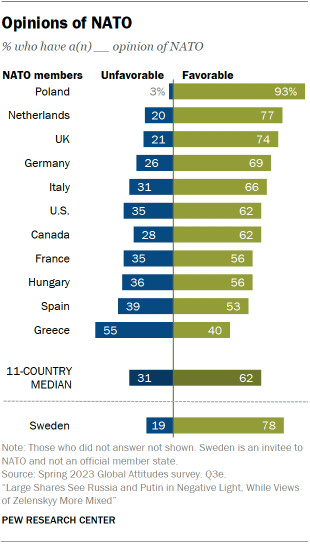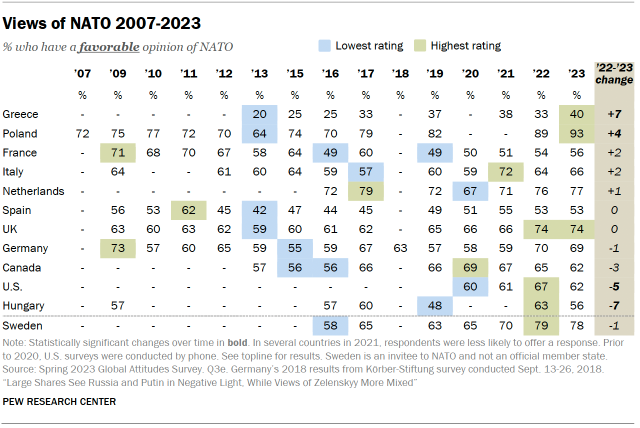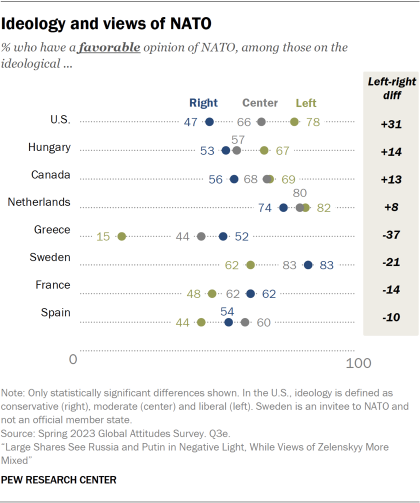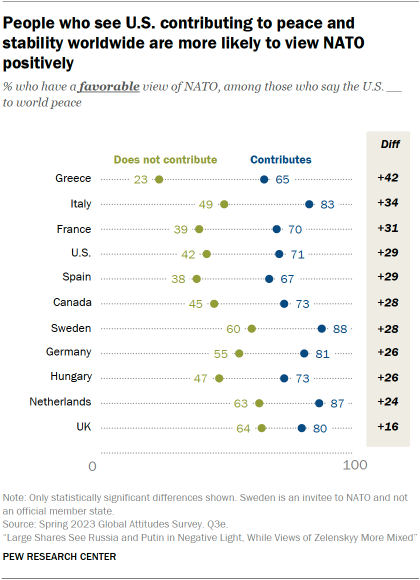
People hold generally positive views of NATO, the North Atlantic Treaty Organization, in the 11 NATO member states surveyed. Across these states, a median of 62% have a positive view of NATO, while 31% have an unfavorable view of the military alliance.
Favorable views of NATO are highest in Poland, where 93% hold a positive view of the defense organization. In the Netherlands, UK, Germany and Italy, roughly two-thirds or more have a positive view of the transatlantic alliance. Among Americans, 62% have a favorable view of NATO, compared with 35% who hold an unfavorable view. Canadians hold similar opinions.
Related: Americans Hold Positive Feelings Toward NATO and Ukraine, See Russia as an Enemy
Majorities in France and Hungary see NATO favorably, even as Hungary remains one of the NATO countries which have not yet accepted Sweden as a new member. Just over half in Spain have a favorable view of NATO as well. Among the NATO countries surveyed, Greece is the only one where a majority has an unfavorable view of the alliance.
Sweden, which is waiting on Turkey and Hungary’s approval to be accepted fully into the alliance, is among the most bullish on the alliance, with 78% holding a favorable opinion of it.
Opinion of NATO over time
Since February 2022, after Russia’s invasion of Ukraine, there has been minimal change in views of NATO among the member states surveyed. A 7 percentage point increase in positive sentiment among Greeks is coupled with a 7-point decline in favorability among Hungarians. Americans are also slightly down on the alliance. But goodwill toward NATO is higher than at any time in the last decade and a half in Greece, Poland and the UK.

How politics and views of the U.S. affect views of NATO
Ideology in each country influences views toward NATO.

In terms of political ideology, there are mixed effects. In the U.S., Hungary, Canada and Netherlands, those on the political left are much more supportive of NATO than are those on the political right. The political divide is especially large in the U.S., where 78% of liberals have a positive view of NATO compared with 47% of conservatives.
But in Greece, Sweden, France and Spain, those on the political right are more favorably inclined toward NATO compared with those on the left. And the political divide in Greece on this question is the largest among the countries surveyed.

Another interesting connection between views of NATO and U.S. power is that people who see the U.S. contributing to peace and stability around the world are more likely to have positive feelings toward NATO.
In fact, this is true in every NATO country surveyed except Poland, where there are not enough people who say the U.S. does not support world peace to analyze.
For example, 65% of Greeks who say the U.S. helps keep the world stable have a positive view of NATO, compared with 23% among those who do not think the U.S. is a source of stability. Even in the U.S., there is a large statistically significant gap on this aspect of American power and its connection with NATO.




